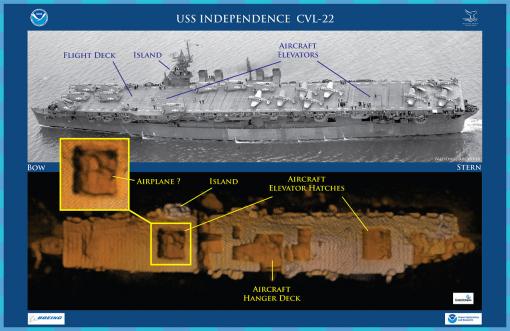USS Independence - Atomic history in California's blue backyard

You're invited to explore a piece of WWII history with the team of E/V Nautilus in the blue ocean backyard of central California!
Continuing the Nautilus Exploration Program’s mission to explore the oceans, the Corps of Exploration on E/V Nautilus and scientists on shore participating via telepresence will conduct the first-ever visual survey of the sunken aircraft carrier USS Independence. In 1951, Independence was scuttled offshore San Francisco where she now rests within the Monterey Bay National Marine Sanctuary. The wreck was acoustically surveyed in 2015 by The Boeing Company and Coda Octopus working with NOAA’s Office of National Marine Sanctuaries’ Maritime Heritage Program and West Coast Region, NOAA’s Office of Ocean Exploration and Research. Our expedition will be the first time humans will lay eyes on Independence in over 65 years.

The team is pleased to partner with NOAA’s Office of National Marine Sanctuaries, the Office of Naval Research, and the Naval Historical Foundation to bring live exploration of a piece of American history to the world. Together we will witness the latest chapter in the ship’s storied life as it is transformed into a diverse, marine habitat. To learn about Independence from the men who served valiantly on her decks, explore these eyewitness accounts of her service collected by the Naval Historical Foundation. http://www.navyhistory.org/eyewitness-to-uss-independence/
At her christening, Independence represented the first of a new class of carriers built on converted cruiser hulls. She joined the Pacific Fleet in June 1943. She participated in major campaigns of the Pacific front in attacks on Rabaul, Tarawa, Luzon, and Okinawa. Most notably, Independence was part of the carrier group that sank the last remaining vestige of the Japanese Mobile Fleet at the Battle of Leyte Gulf, including the battleship Musashi. USS Independence received eight battle stars due to the heroic actions of the Sailors, Officers, Pilots and Marines who served onboard. To learn more about the history of Independence’s service in the war, visit http://www.navyhistory.org/uss-independence-historical-timeline/
After the war, the ship had another important national service yet to perform. Selected as a target vessel for the Bikini atomic bomb tests - code named Operation Crossroads - she was placed within one-half mile of ground zero for the 1 July explosion (Test Able). The ship was severely damaged but did not sink and took part in an underwater detonation test 25 July (Test Baker). The third atomic test (Test Charlie) was canceled due to growing concern over the water conditions within Bikini Atoll. Decommissioned at Kwajalein Atoll on 22 August 1946, the “ex-Independence” was towed to San Francisco by ocean tugs USS Hitchiti and USS Pakana, arriving at Hunters Point in the San Francisco Bay in June of 1947. At Hunters Point the Navy would establish the NRDL – Naval Radiological Defense Laboratory and Independence became a training school to study the aftereffect of the atomic bombs on the target vessels. To learn more about Independence’s role in Operation Crossroads, visit http://www.navyhistory.org/2016/08/uss-independence-cvl-22-and-operation-crossroads/

In the political climate of the late 1940s with growing espionage concerns of the Cold War, Independence was scuttled offshore of San Francisco in the waters now within the Monterey Bay National Marine Sanctuary. This area is managed by the Greater Farallones National Marine Sanctuary team who are leading the current Nautilus expedition. There are over 4000 shipwrecks within the network of National Marine Sanctuaries with over 400 of them resting within Greater Farallones National Marine Sanctuary.
While diving on Independence the dive goals will include conducting a systematic site investigation working under permit from NOAA and with supervision from NOAA and the Navy History and Heritage Command. We will conduct video surveys to identify vessel construction details and damage from the Bikini tests, and document the formation process of the wreck as a biological habitat. We’ll study the growth of corals, sponges, and encrusting invertebrates across this massive substrate. The Corps of Exploration with ROV Hercules will conduct the first survey of Independence to collect photomosaic and microbathymetry data. These high resolution images will help construct a visual overview of the wreck impossible to gather from a single point-of-view. This survey will also compare the current state to the condition in the post-atomic test damage reports.
For more information about the maritime heritage of Independence and other shipwrecks within the National Marine Sanctuaries visit http://farallones.noaa.gov/welcome.html
Vital Stats of Independence
Type - Light Aircraft Carrier
Class - Independence
Builder - New York Shipbuilding Corporation
Built In - Camden, New Jersey
Length - 622.5 feet overall
Beam - 71.5 feet (waterline), 109.16 (extended flightdeck)
Draft - 26 feet (loaded)
Hull Material - Steel
Machinery - 4 Steam Turbines
Propellers - 4 Four-blade, 12.0’ diameter
Horsepower - 100,000 (shaft)
Launched - August 22, 1942
Scuttled - January 26, 1951

Greater Farallones National Marine Sanctuary
Nautilus will return northward along the California coastline for a cruise to study the cultural heritage and natural wildlife in the Greater Farallones National Marine Sanctuary (GFNMS). Recently expanded to protect 3,295 square miles, GFNMS contains over 400 shipwrecks and is largely unexplored in the deepest portions.



